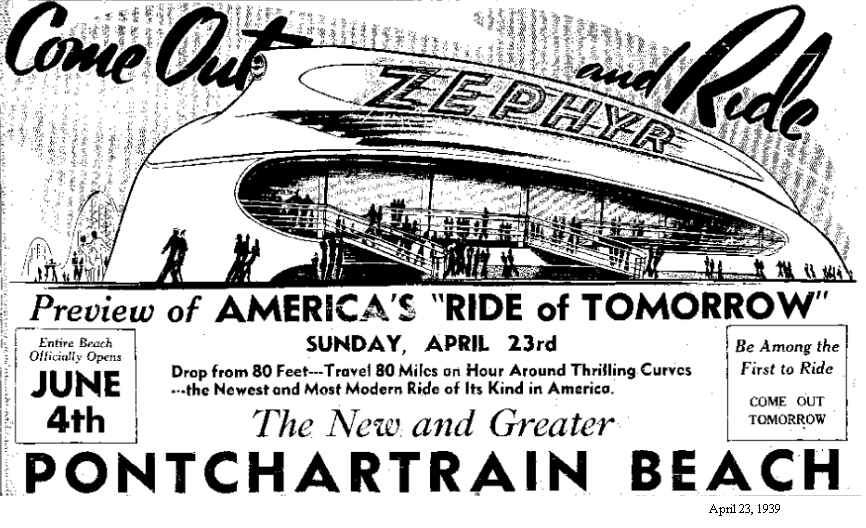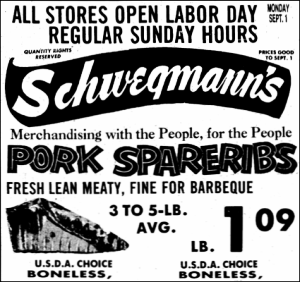|
Today in New Orleans History |
|
|
June 26


 Buy a Lot In Bonnabel Place June 26, 1927 -- Times-Picayune North and South Turnbull
drives, running from the the Earhart Expressway (named for former New Orleans Commissioner of Public Utilities,
Fred A. Earhart) to the lake are named for Joseph F. Turnbull, the real estate developer who was touting lots
in the new Bonnabel Place subdivision on June 26, 1927. Running from Metairie Road to the lake, Bonnabel Place was owned
by heirs of Parisian chemist Henri Bonnabel who had come to New Orleans in 1825. He had purchased the eleven arpents
wide (an arpent is a French unit of measure which is slightly smaller than a acre) property from Hypolite deCourval in 1836.
It ran from the river to the lake. Henri worked with French engineer J.A. D’Hemecourt, to lay
out a town on Metairie Ridge which he named Bath #1, in honor of an English town. Bath #1 would became Bonnabel Place Subdivision.
After Henri's death, his son Alfred subdivided the Bonnabel tract into two subdivisions -- Bonnabel Place and Old Homestead
during the mid-1910s. Alfred's son Alfred E. Bonnabel, a surveyor who was commissioned by the state Surveyor Of Jefferson
Parish also conducted the official survery for his family property. His wife, Luella, named the streets after mythological,
historical and literary figures. The town of Metairie had recently been incorporated when this advertisement
was run but but gambling interests were successful in overturning that endeavor. What did materialize was Bonnabel Boulevard
from Metairie Road to the Lake with its north to south running streets which were among the first to be devolped north of
Metairie Road. St. Catherine school and church were already in place in their current location (after the country chapel
at Labarre Road had been abandoned), what would become Metairie High School fronted Metairie Road a few blocks away as well
as the Metairie Ridge Presbyterian Church. In reference to another plan which never fully materialized,
this advertisement notes that Metairie Road (paved at this time) would connect to the "soon to be constructed and surfaced
Lake Shore Highway from West End to Hammond". The only remaining stretch of it, we now know as Hammond Highway
in Bucktown. A road was built along the lakeshore to Kenner but without a levee to protect it, it fell into disrepair. This ad ran when a streetcar ran along Metairie Road. Bonnabel at Metairie road was "only 5. 2
miles from Canal at Rampart...take the Shrewsbury car (Napoleon Avenue line) and ask the conductor to put you off at Bonnabel
Boulevard",  

To receive an update for each day in New Orleans
history, join our facebook page
- Today in New Orleans History
Tweet
Anne Elisabeth Jane "Liz" Claiborne (March 31, 1929 – June 26, 2007) was
a fashion designer and entrepreneur. Claiborne is best known for co-founding Liz Claiborne Inc. which in 1986 became the first
company founded by a woman to make the Fortune 500. Claiborne was the first woman to become chairperson and CEO of a Fortune
500 company. Claiborne was born in Brussels to American parents. She came from a prominent Louisiana family with an
ancestor William C.C. Claiborne having been Governor of Louisiana during the War of 1812. In 1939, at the start of World War
II, the family returned to New Orleans. (WIKI) Earl Humphrey, born in New Orleans on September 9, 1902, was an American jazz trombonist. He was the
brother of noted New Orleans jazz players Willie Humphrey and Percy Humphrey. Earl Humphrey learned to play trombone from
his grandfather, and joined a traveling circus with his father in 1919. He traveled widely in the 1920s, and in 1927 recorded
with Louis Dumaine. He played through the 1930s but retired to Virginia in the 1940s. In 1963 he returned to New Orleans,
where he was urged to resume his musical career. He joined his brother Percy's band and played on a few albums, including
Jazz City Studio. He recorded his first sessions as bandleader in the mid-1960's; Igor's Imperial Orchestra (1966) and Earl
Humphrey & His Feetwarmers (1967) on the Center label. Earl died at his home in New Orleans on June 26, 1971
at the age of 68. (WIKI)
Jean Charles Faget was a physician born on June 26, 1818 in New Orleans. He is best known
for the Faget sign—a medical sign that is the unusual combination of fever and bradycardia. The sign is an important
diagnostic symptom of yellow fever. |
|
|

To receive an update for each day in New Orleans history,
join our facebook page - Today in New
Orleans History.
Analytics |


